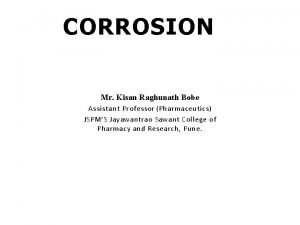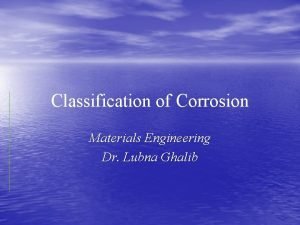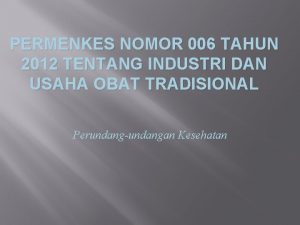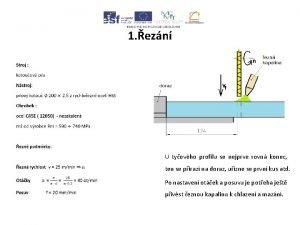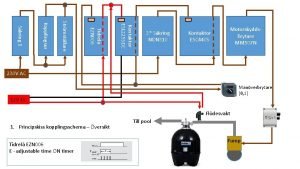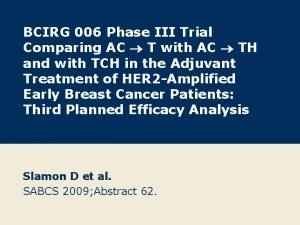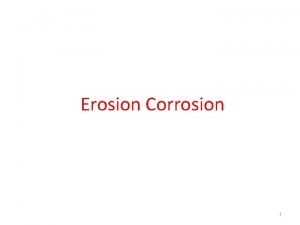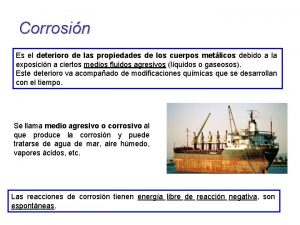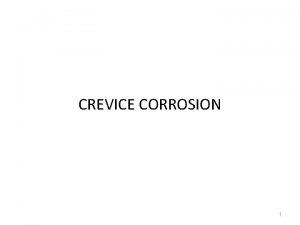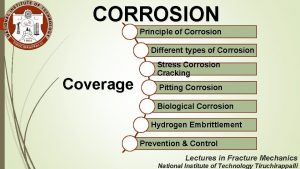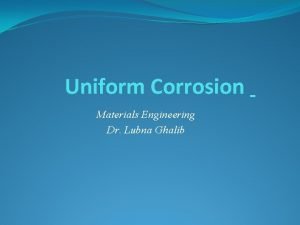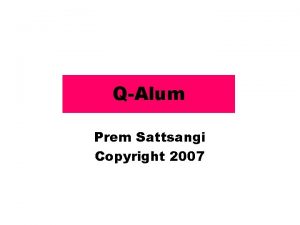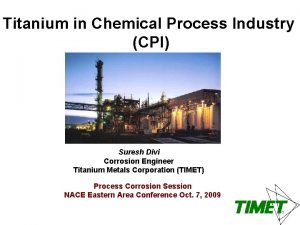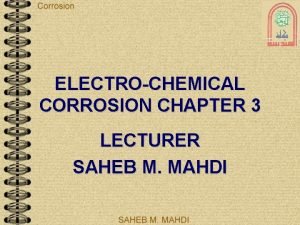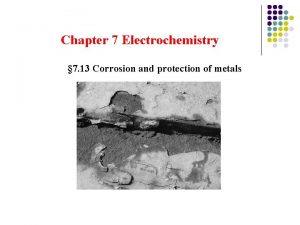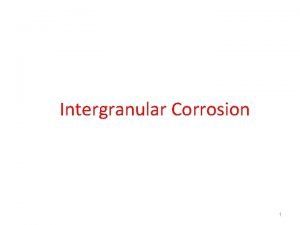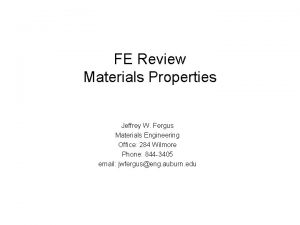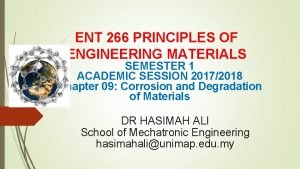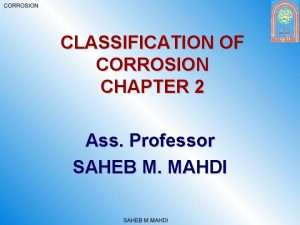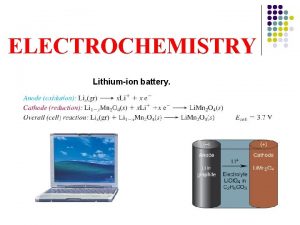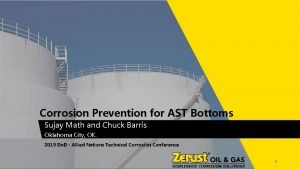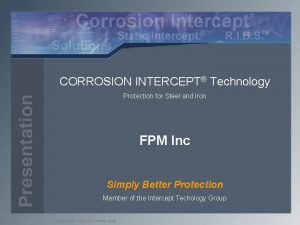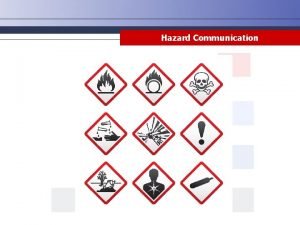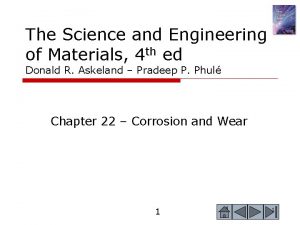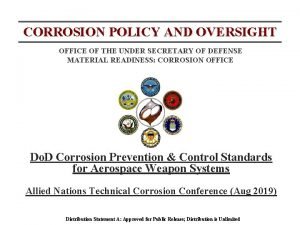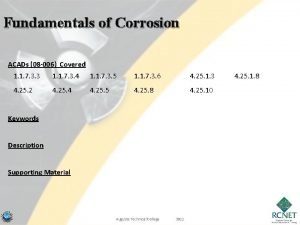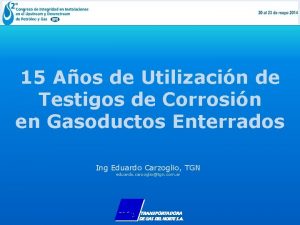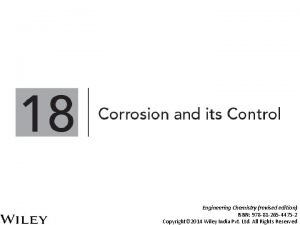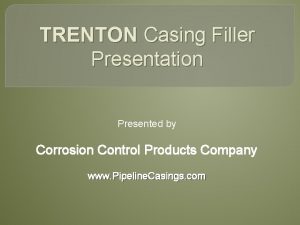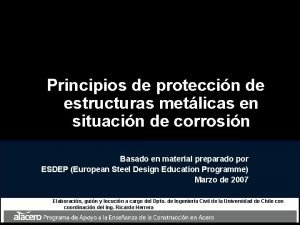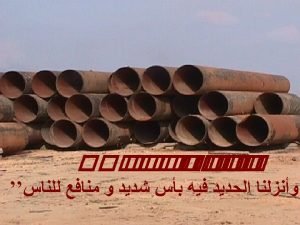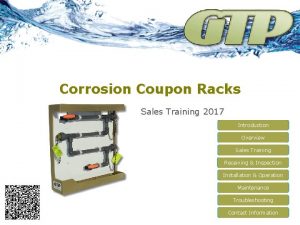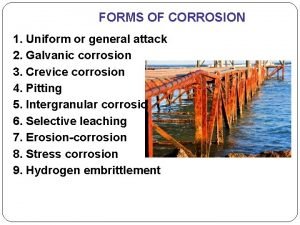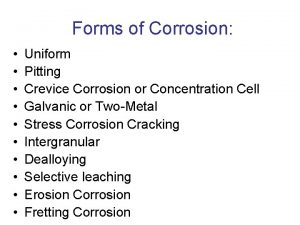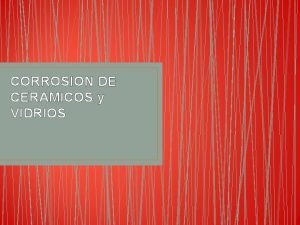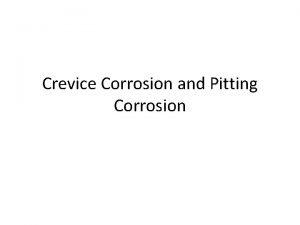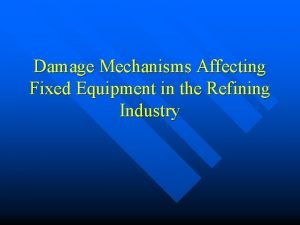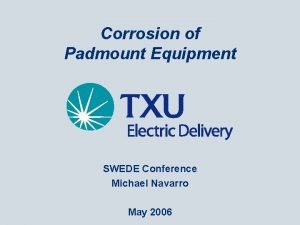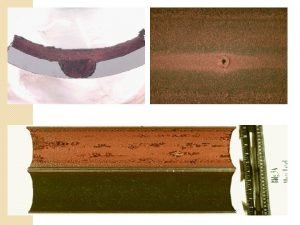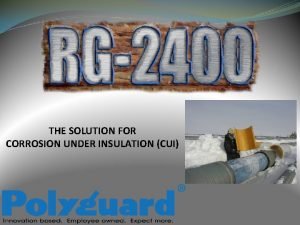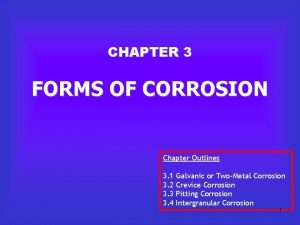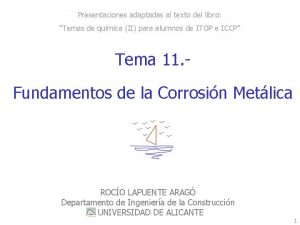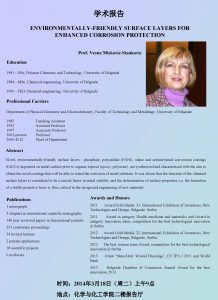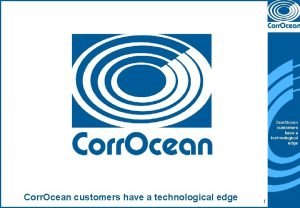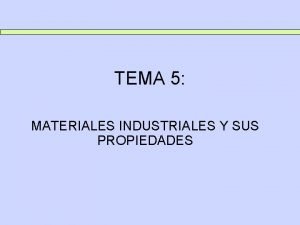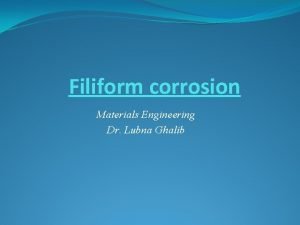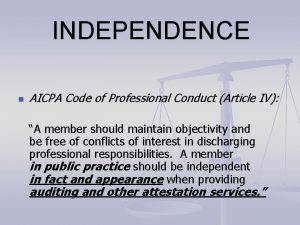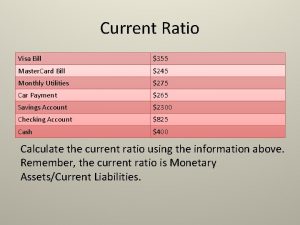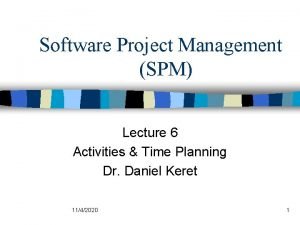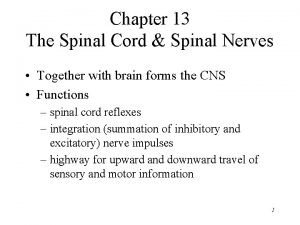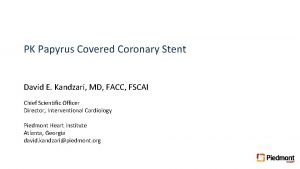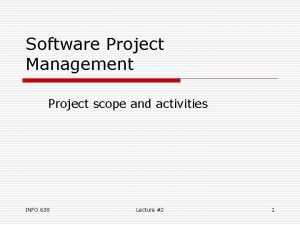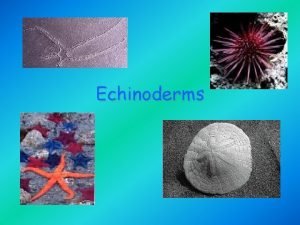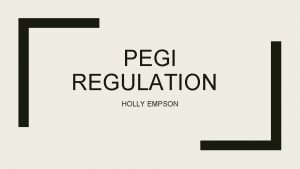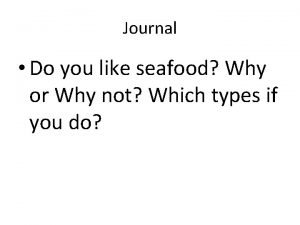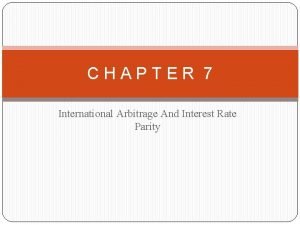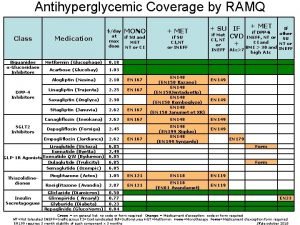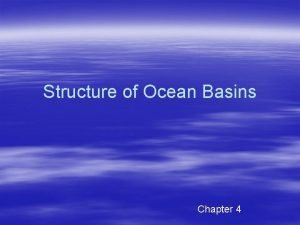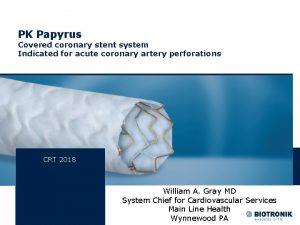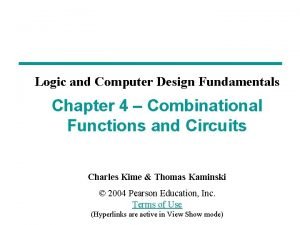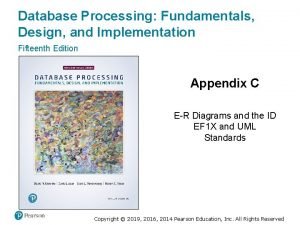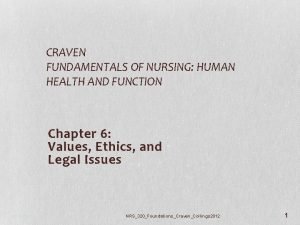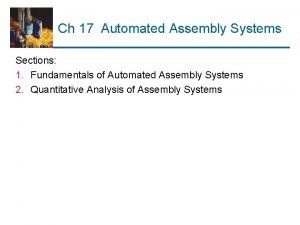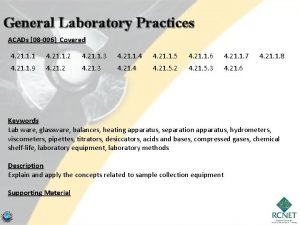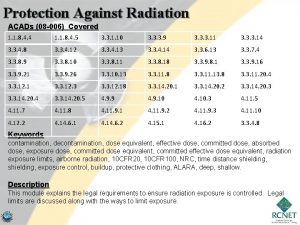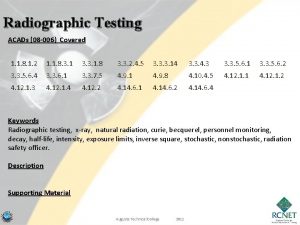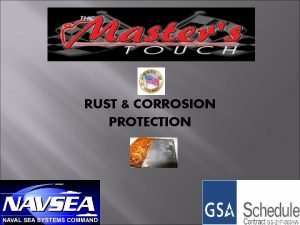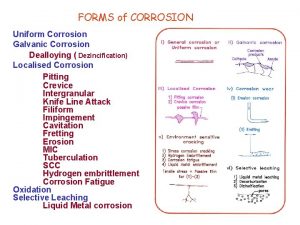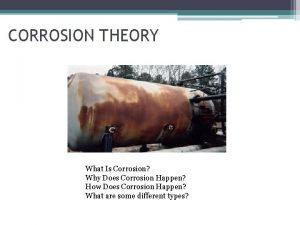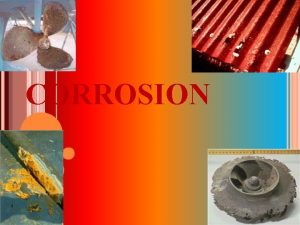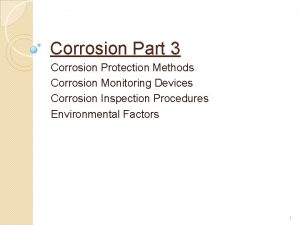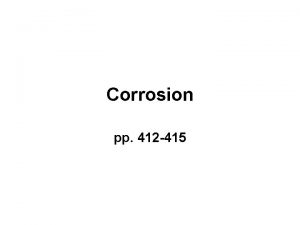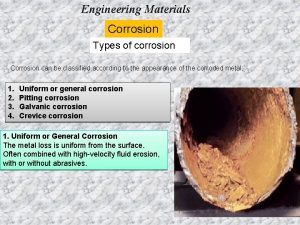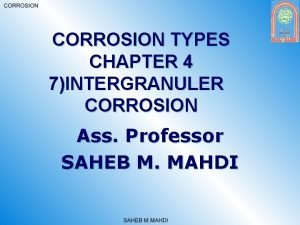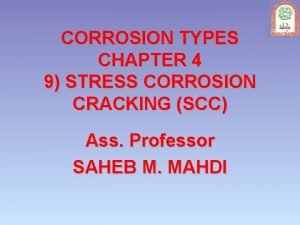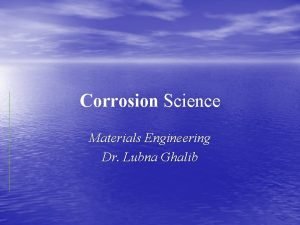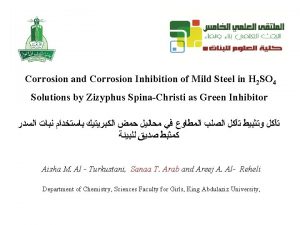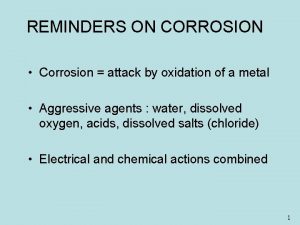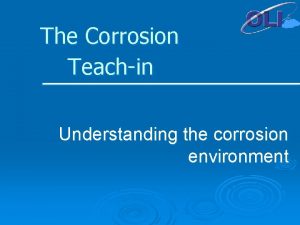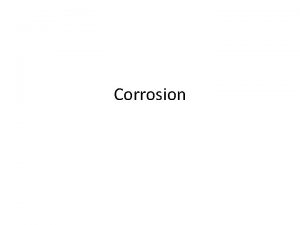Fundamentals of Corrosion ACADs 08 006 Covered 1








































































































- Slides: 104

Fundamentals of Corrosion ACADs (08 -006) Covered 1. 1. 7. 3. 3 1. 1. 7. 3. 4 1. 1. 7. 3. 5 1. 1. 7. 3. 6 4. 25. 1. 3 4. 25. 2 4. 25. 4 4. 25. 5 4. 25. 8 4. 25. 10 Keywords Description Supporting Material Augusta Technical College 2011 4. 25. 1. 8

Fundamentals of Corrosion Prepared by Ivelisse Ortiz-Hernandez, Ph. D. Source: File h 1015 v 1 from the DOE, Module 2 2

Objectives • Without references, DESCRIBE the causes and effects of corrosion on metals and the type of chemistry used in a plant to minimize corrosion. 3

First Enabling Objective • 1. 1 DEFINE the following terms: a. Ionization b. Conductivity c. Corrosion d. Electrolysis e. General corrosion f. Wastage 4

Why is corrosion control important? • Rapid localized corrosion may lead to penetration of the metal containing the coolant. Radioactive coolant would then leak from the system and jeopardize safe operation. • Corrosion of the nuclear fuel cladding may cause the cladding to become brittle and less ductile. – The swelling from the generation of fission gases within the fuel may then cause the cladding to crack or blister, and highly radioactive fission products may then be released to the coolant. • Some of the metallic oxide corrosion products released to the coolant may be deposited on surfaces in the reactor core. – The solids when in contact with the neutron flux become radioactive and accumulate in different regions throughout the system and outside the core. – Results in issues with maintenance and radiation levels outside the core. 5

Basic Definitions • Current is the flow of electrons through a medium. A metal conducts electricity without changing its properties. This is called metallic conduction. • Ionization is the process of adding electrons to or removing electrons from atoms or molecules, creating ions. High temperatures, electrical discharges, and nuclear radiation cause ionization. – Current can be conducted by the movement of these ions. • The compounds that conduct electric current by ion movement are called electrolytes, and this ionic motion is call electrolytic conduction. • Conductivity is a measure of the ability of a substance to allow electron flow. – Conductivity indicates the amount of ions in solution, which relates directly to the potential of corrosion taking place. 6

Definition of Corrosion • Corrosion is the deterioration of a material due to interaction with its environment. • Electrolysis is the decomposition by electric current (in the context of corrosion the use of electrical current to bring about chemical change). • An electrolyte is defined as an electricity-conducting fluid; that is, it has positive and negative ions that can move and constitute an electrical current. • Pure water is a poor conductor (contains H+ and OH- ions only). When a salt is added it becomes a good conductor. • Corrosion is electrochemical in nature because the corrosive chemical reactions involve transfer of charge. 7

Corrosion of Iron in the presence of water or acidic water • Iron goes into solution as Fe++ ions. As these ions go into solution, the metal becomes negatively charged (by the electrons left behind) with respect to the electrolyte. • Potential difference is observed. 8

Electrochemical Cells • The sites at which the oxidation takes place on the surface of the metal become electrochemical cells made up of micro-electrodes of the two different substances; the metal and the electrolyte. • These micro-electrodes set up many micro-cells connected through the bulk of the metal. • The ability of a metal to corrode will depend on the potential difference between the metal and the electrolyte. – For example, magnesium and zinc go into solution to a greater extent than iron, and these metals will be more negative with respect to the electrolyte than iron. – Nickel, lead, and copper go into solution less readily and produce a smaller potential difference. – The potential difference depends on the ability of the metal to gain or loose electrons. • Table 1 lists the potential differences for various metals in water. It changes with different electrolytes. 9

10

Two Types of Electrochemical Cells 11

Electrochemical Cells • Oxidation potential describes the ability to loose electrons. This takes place at the anode. • Reduction potential reflects the ability to gain electrons. Takes place in the cathode. • The potential is measured with respect to a reference. In this case, the reference is the hydrogen electrode. • The most negative potentials represent the strongest reducing agents. • Types of cells: galvanic (electrodes of two different substances) and concentration cells (same electrodes with different concentrations). 12

Electrochemical Cells There are two types of electrochemical cells: galvanic (ones that spontaneously produce electrical energy) and electrolytic (ones that consume electrical energy). 13

A potential difference between two electrodes represents a tendency for the reaction to occur. 14

• For electrochemical reactions to take place the microcells must be interconnected. • Connection established by the water/electrolyte solution and the cells produce electrical current allowing the reaction to take place. • Normally the reaction is expected to continue until the difference in potential between the negatively charged metal and positively charged solution is zero. – In this case iron will not leave the surface. – Impurities and imperfections will cause preferential oxidation of one region versus another resulting in localized corrosion. 15

Oxidation and Reduction Reactions • The corrosion of a metal (that is, the chemical transformation that is recognized as destructive to the metal) is the oxidation step of the overall oxidation-reduction process. • Oxidation is the process of losing electrons; reduction is the process of gaining electrons. Example of a REDOX reaction 16

Oxidation and Reduction Reactions • After the metal looses electrons it forms a positively charged ion. • The reaction takes place at the anode. • The cations (positive ions) may then go into solution, or they may combine with any available anions (negative ions) or water to form ionic compounds. • The metal decomposes as it corrodes. • Oxidation must be followed by a reduction. • For most metals in an aqueous environment, the important reduction half-reaction is the reduction of hydronium ions (a hydronium ion is simply a hydrogen ion attached to a water molecule). 17

Corrosion Types • The corrosion in a plant depends in the minerals present in the cooling water and the dissolved oxygen. • During corrosion a chemical reaction takes place at the water-metal interface. • General corrosion – widespread chemical reaction in the metal surface. • Localized corrosion – occurs when specific areas are attacked faster than others. – Affected by different conditions in a localized area like stress, fatigue, erosion, and other forms of chemical attacks. 18

General Corrosion • Results in the uniform removal of material from all metal surfaces in contact with water. • Corrosion takes place in the surface of one metal. • Corrosion is dependent on the composition of the water, the type of metal, and the environmental conditions in the plant. • Iron is unstable when in contact with water and dissolves to form ferrous ion (Iron (II) ion) while releasing electrons. 19

Wastage • Corrosion specifically refers to any process involving the deterioration or degradation of metal components. • Corrosion processes are usually electrochemical in nature, having the essential features of a battery. – When metal atoms are exposed to an environment containing water molecules they can give up electrons, becoming themselves positively charged ions, provided an electrical circuit can be completed. • This effect can be concentrated locally to form a pit or, sometimes, a crack, or it can extend across a wide area to produce general wastage.

Wastage Corrosion Tests • Saturated Boric Acid Solution at 97. 5°C • Molten H–B–O Environment at Ambient Pressure • High–Temperature High–Pressure Boric Acid Solutions • Effect of Chromium Content on Corrosion Rate

General Corrosion • When the ferrous ions come into contact with hot water the reduction of hydrogen takes place. • The iron (II) ion reacts to form mangnetite (Fe 3 O 4). • The magnetite forms a protective layer. 22

General Corrosion • As the reaction takes place, the ferrous ions must pass through this layer to further react with water. • Once a thick enough layer is formed, the reaction slows down considerably. • Problem: If the magnetite particles are released into the stream of water, the particles can cause problems in small passages. • New systems go through a “conditioning” process to intentionally form a stable corrosion layer. 23

Corrosion Mechanism: Formation of Rust 24

Passivity and Polarization of a Metal • Metals that normally fall victim to corrosion will sometimes exhibit a passivity to corrosion. • Passivity is the characteristic of a metal exhibited when that metal does not become active in the corrosion reaction. • Passivity is caused by the buildup of a stable, tenacious layer of metal oxide on the surface of the metal. • Once the layer, or film, is formed, it acts as a barrier separating the metal surface from the environment. • The steel example above discusses the use of passivity in a process. 25

• Metals such as zirconium, chromium, aluminum, and the stainless steels form thin, tenacious oxide films when exposed to the atmosphere or to pure water at room temperature. – Very effective in minimizing further corrosion. 26

• An active electrochemical cell (oxidation-reduction reaction) is an unstable chemical system. • The potential associated with a galvanic cell, for example, steadily decreases as current flows and the oxidation-reduction reaction proceeds. Reaction stops when the electric potential goes to zero (no net reaction). – At this point the system is at equilibrium. • In electrochemical cells, the decrease in cell potential caused by the operation of the cell (current flow) is called polarization. 27

• An active electrochemical cell (oxidation-reduction reaction) is an unstable chemical system. • The potential associated with a galvanic cell, for example, steadily decreases as current flows and the oxidation-reduction reaction proceeds. Reaction stops when the electric potential goes to zero (no net reaction). – At this point the system is at equilibrium. • In electrochemical cells, the decrease in cell potential caused by the operation of the cell (current flow) is called polarization. 28

Example of Corrosion • For example, for galvanic corrosion to take place we need two dissimilar metals with a difference in their potential. • As the reaction takes place, Zn+2 ions (produced by the oxidation of zinc metal) pass into solution. The Cu+2 ions in solution are reduced as the copper metal plates out. • Thus, the concentration of Zn+2 in solution increases and the concentration of Cu+2 decreases according to the following overall reaction. 29

Galvanic Cell As Zn+2 increases and Cu+2 decreases, the electrical potential decreases. This decrease in cell potential, which results from changes in concentrations, is 30 one form of polarization called concentration polarization.

• Polarization is the decrease in cell potential caused by the operation of the electrochemical cell. • Polarization can be in two forms; concentration or activation. – Concentration polarization is associated with the concentration of ions in solution which shields the metal, thereby causing a decrease in the electrical potential of the cell. – Activation polarization is the formation of a layer containing absorbed hydrogen atoms that block the metal's surface from the corrosion process. 31

Galvanic Cell: Zinc and Platinum Electrode Again, as the cell operates, the cell potential drops. The decrease is partially due to the increase in Zn+2 concentration and the decrease in H 3 O+ concentration. The second type of polarization is associated with the reduction half-reaction. Hydrogen ion remains in the surface of the Pt electrode until it either recombines with a second hydrogen atom to form molecular hydrogen, H 2 or are removed by reacting with oxygen to form water. The sites are blocked until the hydrogen is removed. 32

Galvanic Cell: Zinc and Platinum Electrode • Reaction 2. 6 is the slowest step in the process because it requires the greatest amount of energy to proceed (highest activation energy). – 2 H H 2 Reaction 2. 6 • Because the oxidation half-reaction can occur no faster than the reduction half-reaction, the rate of the overall oxidation-reduction reaction is controlled by the reaction of Equation (2 -6). • This type of polarization is called activation polarization and is sometimes referred to as hydrogen polarization, or cathodic polarization, because the polarizing reaction occurs at the cathode. • Both concentration and activation polarization decrease the net oxidationreduction reaction rate. • In corrosion processes, activation polarization usually has the greater effect. 33

General Corrosion • Conditions that lead to general corrosion – 1) metal and water in the same environment, and – 2) a chemical reaction between the metal and water that forms an oxide. 34

Oxidation of Iron • Under operating conditions, assume that the water is deaerated, at room temperature and with a p. H close to neutral. 35

• Once the oxide layer has formed the metal is not in direct contact with the water. For the reaction to continue the electrons and ions most diffuse through this layer. • The magnetite layer develops in between the Ferrous oxide and ferric oxide layer. • The electrons participate in the reduction reaction with hydronium ions. • These latter reactions are believed to take place predominately at the oxide-water interface, but some reaction may occur within the oxide layer by the diffusion of H+ , OH- , and H 2 O into the layer. 36

The protection provided by the film depends on the tenacity of the film. A loosely attached film will continue to corrode. If defects develop in the film, corrosion will take place. 37

Factors Affecting General Corrosion Rate • Corrosion rates increase as temperature increases. • Temperature and pressure of the medium govern the solubilities of the corrosive species in the fluid, such as oxygen (O 2 ), carbon dioxide (CO 2 ), chlorides, and hydroxides. • A rule of thumb is that the reaction rate doubles with a 20°F to 50°F temperature rise. This linear increase with temperature does not continue indefinitely due, in part, to a change in the oxide film. • High fluid velocities can remove the corrosion layer and increase the rate of corrosion. – Known as erosion. – Water velocities of 30 to 40 ft per second are usually considered to cause erosion. 38

• The presence of oxygen in water increases the corrosion rate. • The reason for this increase is the rapid reaction between oxygen and the polarizing layer of atomic hydrogen absorbed on the oxide layer. • Reaction 2. 11 removes the polarizing layer. • Overall reaction: 39

• Oxygen, therefore, has two effects: – it removes the polarizing layer of atomic hydrogen, and – it can react directly with the metal or metal oxide; thus, the corrosion rate increases. • • Oxygen is known as a depolarizer. p. H also affects the corrosion rate. At a p. H of less than 4 the Fe. O is soluble. In the range of p. H 4 to p. H 10, the corrosion rate of iron is relatively independent of the p. H of the solution. 40

• At lower p. H the film cannot accumulate in the surface of the metal. – Corrosion takes place at a higher rate. • At p. H above 10 corrosion rate decreases. • This is believed to be due to an increase in the rate of the reaction of oxygen with Fe(OH)2 (hydrated Fe. O) in the oxide layer to form the more protective Fe 2 O 3 (note that this effect is not observed in deaerated water at high temperatures). 41

Effect of p. H • • In the range of p. H 4 to p. H 10, the corrosion rate of iron is relatively independent of the p. H of the solution. For p. H values below 4. 0, ferrous oxide (Fe. O) is soluble. Thus, the oxide dissolves as it is formed rather than depositing on the metal surface to form a film. Formation of hydrogen at lower p. H means that depolarization with oxygen and hydrogen evolution are both playing a role. 42

Corrosion layer is compromised at low and high p. H at higher temperatures. A p. H between 7 and 10 gives a lower rate of corrosion. The p. H is always maintained alkaline to minimize corrosion rate. Having hydrogen in the water helps minimize the amount of corrosion by eliminating the amount of oxygen in the system. Dissolved oxygen reacts with the protective hydrogen gas layer at the cathode to form water. 43

Aspects Affecting Corrosion Rate • The condition and composition of the metal surfaces affects the corrosion rate. – Deposits, scale, or irregular surfaces create areas on the metal where local corrosion can initiate and proceed at a faster rate than normal. • When iron or steel is exposed to high temperature water, the rate of corrosion of the metal is observed to decrease with exposure time during the early period of exposure. – After exposure to hot water for a few thousand hours the corrosion rates reaches equilibrium at a low level of corrosion. – The rate at which the corrosion layer develops decreases as the level of corrosion slows down. After a few thousand hours, the film does not grow any longer. 44

• Because a tightly adhering corrosion film inhibits further corrosion, great care is taken during the initial fill of reactor plants to promote formation of the best possible corrosion film. • This process, referred to as pretreatment, or pickling, involves careful control of reactor coolant water chemistry and temperature during the pretreatment period. 45

Prevention Chemistry Control • Plant chemistry is used to prevent corrosion. • Things done to minimize corrosion include: – Passivators and inhibitors • Passivation is the condition where a naturally active metal corrodes at a very low rate, probably due to an oxide coating or an absorbed layer of oxygen. • Some chemical substances, called passivators or inhibitors, if added to water, can provide this type of passivation by undergoing reduction at the metal surface. Example: Potassium Chromate. – Cathodic Protection • The use of cathodic protection, supplying an external electric current to the iron so that it acts as a cathode and has no anodic areas, is another method of preventative chemical control. Uses a sacrificial electrode as an anode: Zinc. 46

Prevention Chemistry Control • Removing Corrosive agents – One method is using deaerators to remove dissolved oxygen and to a lesser extent carbon dioxide. – Treating the water by softening and demineralization removes the dissolved solids and reduces the conductivity. • Chemical Addition – Involves the addition of a chemical that will alter a chemical reaction or tie up a common corrodant. – Filming amines (organic compounds that are derivatives of ammonia) accomplish protection by forming adhering organic films on metal surfaces to prevent contact between corrosive species in the condensate and the metal surface. – Phosphates and sodium hydroxide are used to adjust the system p. H and remove hardness. 47

Corrosion of Aluminum • Variables include environment, temperature, alloy in question, flow velocities, impurities present in the environment, and chemistry conditions to which it is exposed. • An additional factor that affects corrosion is pretreatment. • Pretreatment, soluble and solid impurities, and chemistry are within the control of the operator and will be discussed in this text. • Experiments have shown that prefilming limits corrosion on aluminum-clad fuel assemblies. • Impurities are major contributors to the corrosion of aluminum. – Sources include the Make up water and impurities from corrosion in other parts of the process. Organic impurities due to resin residues from the ion exchangers can also be observed. 48

Corrosion of Aluminum • Chemistry controls, including p. H, dissolved oxygen, and conductivity, greatly influence the formation and propagation of the oxide film on aluminum surfaces. • Conductivity is a quantitative indication of the impurities present in the system, and p. H theoretically dictates the value of conductivity. • Extensive tests carried out in support of DOE test reactors have revealed that minimum aluminum corrosion results with a p. H of 5. 0 at normal operating temperatures. • Additionally, studies have shown that the aluminum corrosion products also exhibit a minimum solubility at a p. H near 5. 5 at 25ºC. • It should be noted that the values at which minimum corrosion and solubility are found shift to a lower p. H as the temperature is increased. For example, at 300ºC, the value for minimum aluminum corrosion is near p. H 3. 0. 49

50

Corrosion of Aluminum • The conditions that have proven to be most effective in limiting corrosion of aluminum are as follows. – Maintaining p. H slightly acidic with the value of the p. H depending largely upon operating temperature – Elimination of dissolved oxygen – Elimination of soluble and solid impurities – Prevention of the introduction of organic impurities – Pretreatment (or pickling) – Maintaining water purity 51

Crud • In addition to the corrosion film, corrosion products in the form of finely divided, insoluble oxide particles called crud become suspended in the reactor coolant or loosely adhere to metal surfaces. • It can accumulate and foul heat-transfer surfaces or clog flow passages. • It becomes activated when exposed to radiation. • Because crud can be transported throughout the reactor coolant system, it can collect outside the reactor core, causing radiation hot spots that increase ambient radiation levels. • Hot spots caused by collections of crud may occur at the entrance to the purification heat exchanger and other areas of low flow velocity. 52

• The crud release can result from an increased oxygen concentration, a reduced (or significantly changed) p. H, a large temperature change (heatup or cooldown), or a physical shock to the system. • Physical shocks include starting, stopping, or changing pump speeds, or other evolutions like a reactor scram or a relief valve lift. • A sudden release of crud is called a crud burst. – Crud bursts often lead to the removal of protective corrosion films and make the freshly exposed metal more susceptible to additional corrosion. • Another corrosion byproduct is scale, which is made up of deposits on surfaces from the formation of insoluble compounds from normally soluble salts. – Most common are calcium or magnesium carbonates (Ca. CO 3 or Mg. CO 3 ). 53

Alloys used in a Nuclear System 54

Stainless Steel • Composed of Iron, Chromium and Nickel. Also contains carbon. • The addition of at least 12% chromium is what makes it resist corrosion. • The iron, chromium and nickel still undergo corrosion. – Form: Nickel oxide (Ni. O), Chromium oxide (Cr 2 O 3), and magnetite (Fe 3 O 4) – Black layer that adheres strongly to the surface of the metal. 55

Zirconium Alloys • Its surface reacts in a similar way under the presence of water. It reacts to form Zr. O 2. • Zirconium does not absorb protons through it. • It has a high melting point, adequate strength up to 800ºF, and low neutron absorption. • The oxide layer prevents further corrosion from taking place. • Zircaloys are normally used in the core of the reactor. • The corrosion layer formed in this alloy is a passivation layer. 56

Composition of Zircaloy • More than 95% Zirconium and less than 2% of tin, niobium, iron, chromium, nickel and other metals. • Corrosion of Zircaloy must be avoided because it leads to the formation of hydrogen which diffuses through the structure of the metal. • Hydrogen reacts with zirconium to form zirconium hydride. – Zirconium hydride is not as strong as the alloy itself. – Results in a weakened cladding. 57

Zirconium Alloys • Hydrogen embrittlement can take place. – The hydrogen can diffuse into the metal structure and react to form zirconium hydride. – Zirconium hydride is brittle, which can weaken the metal and cause structural failure. – Hydrogen is often a by-product of corrosion. – It is very important to understand that this alloy is a barrier to the release of fission products (cladding). 58

Zirconium Alloys • Zircaloy-4 is less susceptible to hydrogen embrittlement than zircaloy-2 because: Zircaloy-4 contains less nickel. • The introduction of niobium into zircaloy-4 reduces the amount of hydrogen absorption in the metal. • Cladding-protective or insulating layer added on top of another metal. • Used to isolate radiation from escaping the system. 59

Inconel • Composed mainly of nickel (76%) • Also contains chromium. • It forms a corrosion layer that contains Ni. O and chromium oxide. • The corrosion layer serves as a barrier and minimizes further corrosion. • Very slow corrosion rate. • Used in the reactor core and other critical components. • Has a very high temperature resistance and is used for extreme conditions. • Forms a thick self-passivating corrosion layer. 60

Environmental Effects on Corrosion • Variables include – Temperature – Flow rate (velocity of the fluid) – Chemical composition of the solution – Radiation 61

Temperature • As temperature increases corrosion rate increases. – Heat transfer surfaces (heat exchangers) are greatly affected. – Corrosion makes it harder to transfer heat through the metal (lower thermal conductivity). – The thicker the corrosion layer, the greater the amount of heat needed to maintain a constant operating temperature in the reactor core. – As the temperature is increased, then the corrosion rate also increases. 62

Velocity • At high velocity, the corrosion layer will be relatively thin. – The film in contact with the metal is mechanically scrubbed by the passing fluid. • Low flow rate areas have a higher corrosion rate. – Corrosion products can settle on this areas. – Causes maintenance problems because of possible radiation “hotspots”. – Additional protection measures must be taken if repairs must be made in an area affected by high radiation levels (reactor drain). 63

Chemicals in the Water • Chloride ions attack steel, fluoride attacks zirconium, and zinc causes damage to inconel. • Heavy metals (lead, mercury) cause damage in Nickel containing metals (inconel and stainless steel). • The presence of these contaminants must be avoided. 64

Environmental Concern: Radiation • High levels of radiation can change the structure of a metal oxide layer. • The corrosion products can become activated when they are exposed to the core. • Loose particles become a radiation hazard (precipitates on radioactive surfaces) 65

Things to avoid • Thermal shocks – Sudden temperature changes. • Chemical shocks – Bad Chemistry • Mechanical shocks – Possible from pump starts 66

Control of General Corrosion • Reduce Oxygen Content • Use corrosion inhibitors • Maintain a neutral to basic p. H 67

Control of General Corrosion • Reduce Oxygen Content – Use deaerated water – Maintain excess hydrogen in the water (to react with any oxygen) – Adding an oxygen scavenger (like Hydrazine, N 2 H 4) (Only at low temperatures). 68

Localized Corrosion • Localized corrosion takes place a lot faster than general corrosion. • In extreme cases, failure with localized corrosion will take just days. • Only specific metals under specific conditions are susceptible to localized corrosion. 69

What is stress? • When a metal is subjected to a load (force), it is distorted or deformed, no matter how strong the metal or light the load. – Elastic strain – regains its shape – Plastic strain – if after the load is applied the shape is not regained. • The phenomenon of elastic strain and plastic deformation in a material are called elasticity and plasticity, respectively. • Atoms in a material are arranged in a specific geometry which depends in the intermolecular interactions. • To distort the pattern of a crystal, work most be done in the material. • Work = Force times the distance that the force moves • Stress is the internal resistance, or counterforce, of a material to the distorting effects of an external force or load. 70

Example of a Crystal Lattice Structure 71

Types of stress – Residual stresses are due to the manufacturing processes that leave stresses in a material. Welding leaves residual stresses in the metals welded. – Structural stresses are stresses produced in structural members because of the weights they support. – Pressure stresses are stresses induced in vessels containing pressurized materials. – Flow stresses occur when a mass of flowing fluid induces a dynamic pressure on a conduit wall. The force of the fluid striking the wall acts as the load. – Thermal stresses exist whenever temperature gradients are present in a material. Different temperatures produce different expansions and subject materials to internal stress. – Fatigue stresses are due to cyclic application of a stress. The stresses could be due to vibration or thermal cycling. 72

Types of stress • Tensile stress is that type of stress in which the two sections of material on either side of a stress plane tend to pull apart or elongate. • Compressive stress is the reverse of tensile stress. • Shear stress exists when two parts of a material tend to slide across each other in any typical plane of shear upon application of force parallel to that plane. • Compressibility is the ability of a material to react to compressive stress or pressure. 73

Types of Localized Corrosion • • • Stress Cracking Corrosion Caustic Corrosion Galvanic Corrosion Crevice Corrosion Pitting Corrosion 74

Localized Corrosion • Stress Cracking Corrosion – Occurs in alloys – Stress corrosion cracking (SCC) is a type of intergranular attack corrosion that occurs at the grain boundaries under tensile stress. – Most pure metals are immune to this type of attack. – According to the most widely accepted theory, stress corrosion cracking is caused by a process called chemisorption. Unlike relatively weak physical absorption, such as hydrogen gas on platinum metal, chemisorption may be thought of as the formation of a compound between the metal atoms on the surface as a monomolecular layer of the chemisorbed substance, such as Cl-, OH-, Br-, and some other ions. – Conditions for this corrosion to exist • Susceptible metal alloy and a corroding substance • Tensile stress • Oxygen in water • Temperature greater than 140 ºF – A large tensile stress is required for it to occur. 75

Localized Corrosion • Stress Cracking Corrosion, cont. – The stress can come from service loads, residual stress from manufacturing processes, mismatch of components during construction, or a wedging action due to accumulation of corrosion products. – Once a stress is present, the other factors must also be present for corrosion to occur. – A defect initially present then grows as the metal atoms separate under stress, more chemisorption occurs, and the process continues. – Stainless steels containing 18 percent chromium and 8 percent nickel are susceptible to cracking in environments containing chloride ions and in concentrated caustic environments (that is, in environments where the hydroxyl ion concentration is high). – If the environment is severe enough, cracking can occur in a very short period of time. 76

Localized Corrosion • Stress Cracking Corrosion, cont. – To minimize: • Careful fabrication of plant components • Maintain chloride, fluoride and oxygen content below the specified limits. • If oxygen is kept at very low limits, then higher chloride and fluoride limits can be tolerated. • The reverse is also true. 77

Chloride Stress Cracking Corrosion • The three conditions that must be present for chloride stress corrosion to occur are as follows. – Chloride ions are present in the environment – Dissolved oxygen is present in the environment – Metal is under tensile stress • Chloride stress corrosion involves selective attack of the metal along grain boundaries. • In the formation of the steel, a chromium-rich carbide precipitates at the grain boundaries leaving these areas low in protective chromium, and thereby, susceptible to attack. • This form of corrosion is controlled by maintaining low chloride ion and oxygen content in the environment and the use of low carbon steels. 78

Chloride Stress Cracking Corrosion • Chloride ions can enter these systems via leaks in condensers or at other locations where auxiliary systems associated with the nuclear facility are cooled by unpurified cooling water. 79

Chloride Stress Cracking Corrosion • Chloride stress corrosion is a particularly significant problem in the operation of nuclear facilities because of the wide use of austenitic stainless steel, and the inherent presence of high tensile stresses associated with pressurization. • Chloride stress corrosion cracks have been known to propagate in austenitic stainless steel at stresses of about one-fifth yield strength with chloride concentrations of less than 50 ppm. 80

Chloride Stress Cracking Corrosion 81

Localized Corrosion • Caustic Corrosion – Occurs in zircalloy and ferrous metal (iron containing metals). – Conditions required • Susceptible metal • Concentrated Caustic conditions (p. H close to 14) • Tensile stress – Difference between tensile stress corrosion and caustic corrosion is the chemicals involved to start the reaction. 82

CR 1. 1 Corrosion rate as a function of p. H 83

CR 1. 1 Corrosion rate as a function of p. H should be maintained between 7 and 10 Under very caustic conditions, corrosion rate increases (p. H = 14) 84

Localized Corrosion • Caustic Corrosion – To minimize general corrosion of most metal a p. H of 7 or greater. – p. H = 11. 3 – zircaloy corrosion layer is dissolved (p. H must be maintained below 11. 3 to ensure that the zircaloy layer is protected) • Exposure of the zircaloy structure increases the chances of zirchydriding. – The concentrated basic conditions are caused by boiling (basic solution concentrates in crevices). The caustic material plates out of solution. When it is remoistened it creates a region with a highly caustic environment. – Improved resistance to caustic stress corrosion cracking can be given to Inconel by heat treating it at 620ºC to 705ºC, depending upon prior solution treating temperature. – Strict p. H control is the only solution. • Materials cannot be changed and boiling cannot be avoided. 85

Corrosion for Inconel Following the grain boundaries Corrosion for 316 stainless steel 86

Galvanic Corrosion • Two dissimilar metals in contact of electrically conductive water. – One of the metals can develop accelerated corrosion. – The metals must have a different electric potential for the reaction to occur. – The difference in potential creates a small current (flow of electrons). – The metal with the lower oxidation potential readily oxidizes in water. 87

Galvanic Corrosion • Required Conditions – Two dissimilar metals in contact – Oxygen dissolved in water • Both Cu and Zn are oxidized in the presence of oxygen in water. • The electric potential of copper is 1. 90 and for zinc is 1. 65. • Electrons flow from least potential to higher potential. • Copper does not corrode and zinc corrodes at an accelerated pace. 88

How can we do to minimize corrosion? • Reactions • To minimize it – Use corrosion resistant materials – Use materials with similar electronegativity. For example: Cupper and Nickel: 1. 90 and 1. 91. – Use sacrificial anode (to corrode this material intentionally) – Use a transition piece between the metals (the transition piece must have similar properties than the two metals. Prevented by minimizing the oxygen content in water. • 89

Crevice Corrosion • Is a type of galvanic corrosion. • Involves two pieces of the same metal. • Conditions for it to occur – Two closely fitted parts – Soluble salts or oxygen in water. – Occurs if a difference in oxygen concentration or salt concentration exist between the crevice and the surface. – The increase concentration of salt in the crevice increases the corrosion in this area. 90

Crevice Corrosion http: //www. corrosion-doctors. org/Forms-crevice/ 91

Crevice Corrosion • In stage three of the crevice development a few more accelerating factors fully develop: – The metal ions produced by the anodic corrosion reaction readily hydrolyze giving off protons (acid) and forming corrosion products. The p. H in a crevice can reach very acidic values, sometimes equivalent to pure acids. – The acidification of the local environment can produce a serious increase in the corrosion rate of most metals. See, for example, how the corrosion of steel is affected as a function of water p. H. – The corrosion products seal even further the crevice environment. – The accumulation of positive charge in the crevice becomes a strong attractor to negative ions in the environment, such as chlorides and sulfates, that can be corrosive in their own right. From: http: //www. corrosion-doctors. org/Forms-crevice/crevice 3. htm 92

Crevice Corrosion • To minimize – Keep water very pure. – Soluble salt and oxygen must be minimized. – Larger crevices (to minimize high concentration areas) – Continuous movement of the parts will minimize it. 93

• Pitting corrosion occurs where the anodic site becomes fixed in a small area and the formation of holes (deep attack) in an otherwise unaffected area takes place. • Crevice corrosion is a type of pitting corrosion that occurs specifically within the low flow region of a crevice. 94

Air (or oxygen) is bubbled around one electrode, and nitrogen is bubbled around the other. A current flows through the wire connecting the two electrodes. The difference in potential is a result of the difference in oxygen concentration at the two electrode surfaces. At the electrode exposed to nitrogen, electrons are given up by the iron as it is oxidized. As a result, oxidation occurs at the electrode exposed to nitrogen and reduction occurs at the aerated electrode. Corrosion takes place in the oxygen free area and reduction takes place in the cathode. 95

• Oxidation occurs at the electrode exposed to nitrogen and reduction occurs at the aerated electrode. • Oxidation at one electrode and reduction at the other creates a potential and a flow of current through the connecting wire. • Note that loss of metal occurs at the electrode that is deficient in oxygen. • In iron that is exposed to water, a similar action can occur if adjacent areas of the metal surface become exposed to solutions with different oxygen concentrations. • Oxygen in the solution inside the crevice will be depleted initially by the corrosion reaction. 96

• A differential in the oxygen concentration inside the crevice versus outside the crevice results in a concentration cell. • The two adjacent areas then establish a concentration cell with electrons flowing from the region of low oxygen concentration to the region of high concentration. • Thus, metal goes into solution (oxidation) inside the crevice, and reduction occurs outside the crevice. • Metal ions diffuse out of the crevice, more metal dissolves, and the process continues. This results in the formation of a pit inside the crevice. 97

98

• The presence of oxygen can also promote pitting at areas on the metal surface that are initially anodic with respect to an adjacent area. • For example, suppose that adjacent areas on a metal surface exhibit slightly different oxidation potentials. • Oxidation, or loss of metal, proceeds at the region of higher potential. • The overall result is corrosion, or wasting away, of the metal in the anodic region under the thicker film. • Thus, a pit in the metal surface is formed under the mound of surface oxide, as illustrated in Figure 13. • Pitting of this type is common in both low temperature and high temperature iron-water systems if precautions are not taken to remove the oxygen from the water within the system. 99

100

• Pitting and crevice corrosion are a major hazard to a nuclear facility because of the rapid penetration of the metal with little overall loss of mass. • A nuclear facility minimizes pitting and crevice corrosion by the following actions. – Avoiding stagnant or low flow conditions. – Using metals and alloys that are less susceptible to the corrosion. – Avoiding agents in the medium that cause pitting (for example, chlorides and oxygen). – Designing the system and components such that no crevices are present. 101

Pitting Corrosion • Caused by inconsistencies in material composition of the metal and the presence of oxygen and fluoride or chloride. • When the material has differences in potential in nearby portions corrosion can occur. • Oxygen attacks the area most prone to corrosion. The presence of chlorides accelerate the corrosion rate. • Corrosion forms a pit that can eventually cause a rupture. • Minimize by using homogeneous metals and minimizing the presence of oxygen and chloride in solution. 102

Control of localized corrosion • • • Low chloride concentration Low fluoride concentration Low oxygen concentration Neutral to moderate basic p. H Avoid heavy metals like mercury 103

Reference • http: //www. hss. energy. gov/nuclearsafety/ns/ techstds/standard/hdbk 1017/h 1017 v 1. pdf • http: //www. corrosion-doctors. org/Forms. SCC/scc. htm 104
 Differentiate between dry corrosion and wet corrosion
Differentiate between dry corrosion and wet corrosion Differentiate between dry and wet corrosion
Differentiate between dry and wet corrosion Bcirg 006
Bcirg 006 Permenkes no 006 tahun 2012
Permenkes no 006 tahun 2012 Dtfh-006
Dtfh-006 Ezn 006
Ezn 006 Ezn 006
Ezn 006 Car hoare
Car hoare Naca 4421
Naca 4421 (r.s.n.a.o. n° 006-2016- sunat/600000
(r.s.n.a.o. n° 006-2016- sunat/600000 Pilka na železo směr zubů
Pilka na železo směr zubů Sq 006
Sq 006 Bcirg 006 trial
Bcirg 006 trial Caustic embrittlement
Caustic embrittlement Zona catodica
Zona catodica Corrosion type
Corrosion type Caustic embrittlement
Caustic embrittlement Clamp on subsea corrosion-erosion monitor
Clamp on subsea corrosion-erosion monitor Uniform corrosion
Uniform corrosion Aluminium corrosion equation
Aluminium corrosion equation Galvanic corrosion table
Galvanic corrosion table Types of electrochemical corrosion
Types of electrochemical corrosion Waterline corrosion
Waterline corrosion Weld decay
Weld decay Crystal dental fergus
Crystal dental fergus Prevention of corrosion
Prevention of corrosion Classification of corrosion
Classification of corrosion Ki electrolysis
Ki electrolysis 2019 dod allied nations technical corrosion conference
2019 dod allied nations technical corrosion conference Lemförder corrosion protection
Lemförder corrosion protection Skin corrosion symbol
Skin corrosion symbol Chemical corrosion
Chemical corrosion Mil-std-7179
Mil-std-7179 What factors affect the rate of corrosion
What factors affect the rate of corrosion Testigos de corrosión
Testigos de corrosión Galvanic corrosion
Galvanic corrosion Corrosion prevention casing filler
Corrosion prevention casing filler Seamsil 300
Seamsil 300 Tipos de corrosion
Tipos de corrosion Electrodos y electrolitos
Electrodos y electrolitos Corrosion galvanique
Corrosion galvanique Corrosion coupon rack flow rate
Corrosion coupon rack flow rate General attack corrosion
General attack corrosion Erosion corrosion
Erosion corrosion Corrosion del vidrio
Corrosion del vidrio Pitting corrosion
Pitting corrosion Sulfidation corrosion
Sulfidation corrosion Swede conference
Swede conference Prevention of corrosion
Prevention of corrosion Corrosion under insulation primer
Corrosion under insulation primer Corrosion
Corrosion Nerst
Nerst Corrosion control solutions
Corrosion control solutions Subsea erosion monitoring
Subsea erosion monitoring Corrosion propiedad fisica o quimica
Corrosion propiedad fisica o quimica Filiform corrosion example
Filiform corrosion example Nervous system guided notes
Nervous system guided notes Aicpa period of professional engagement
Aicpa period of professional engagement Month’s living expenses covered ratio
Month’s living expenses covered ratio Which of the following processes involve heat?
Which of the following processes involve heat? Software project management activities
Software project management activities External anatomy of spinal cord
External anatomy of spinal cord How much water is there on earth
How much water is there on earth Pk papyrus covered coronary stent system
Pk papyrus covered coronary stent system Virginia physiographic provinces
Virginia physiographic provinces Concept covered answer key
Concept covered answer key Plants can be divided into two groups
Plants can be divided into two groups Interest rate arbitrage
Interest rate arbitrage How much of the earth's surface is covered with water
How much of the earth's surface is covered with water Warships covered with protective iron plates
Warships covered with protective iron plates Scope of activities example
Scope of activities example Angiosperms
Angiosperms Whats the surface of venus
Whats the surface of venus Chordates with bodies covered with feathers.
Chordates with bodies covered with feathers. Taxonomists have divided echinoderms into classes
Taxonomists have divided echinoderms into classes Pegi media aspects covered
Pegi media aspects covered A ________ has the entrails, head, fins, and scales removed
A ________ has the entrails, head, fins, and scales removed Intersecurity arbitrages
Intersecurity arbitrages Ozempic ramq
Ozempic ramq What topics will be covered in this unit
What topics will be covered in this unit Bbfc media aspects covered
Bbfc media aspects covered Broad sediment-covered continental shelves
Broad sediment-covered continental shelves Covered put
Covered put Distance covered per unit time
Distance covered per unit time Four living creatures covered with eyes
Four living creatures covered with eyes Covered entity
Covered entity Pk papyrus
Pk papyrus Misplace modifiers
Misplace modifiers 6 kingdom classification
6 kingdom classification International arbitrage and interest rate parity
International arbitrage and interest rate parity The five major oceans
The five major oceans Covered preposition
Covered preposition Covered call payoff diagram
Covered call payoff diagram A trumpet vine covered an arbour meaning
A trumpet vine covered an arbour meaning Activities covered by software project management
Activities covered by software project management Logic & computer design fundamentals
Logic & computer design fundamentals Chapter 17 fundamentals of nursing
Chapter 17 fundamentals of nursing Unit 1 fundamentals of it
Unit 1 fundamentals of it Fundamentals of design
Fundamentals of design Fundamentals of information systems 9th edition
Fundamentals of information systems 9th edition Fundamentals of information systems 9th edition
Fundamentals of information systems 9th edition Fundamentals of organizing
Fundamentals of organizing Fundamentals of nursing care concepts connections & skills
Fundamentals of nursing care concepts connections & skills Fundamentals of nursing craven
Fundamentals of nursing craven Escapement and placement devices
Escapement and placement devices
